CAA News Today
CAA Seeks Publications Committee Member
posted by CAA — February 29, 2016
CAA invites nominations and self-nominations for one member-at-large to serve on the CAA Publications Committee for a three-year term, July 1, 2016–June 30, 2019.
The Publications Committee is a consultative body that meets three times a year. It advises the CAA Publications Department staff and the CAA Board of Directors on publications projects and meets with chairs of the editorial boards of The Art Bulletin, Art Journal, and caa.reviews three times each year. The committee chooses candidates to serve on CAA’s book-grant juries; sponsors a practicum session at the Annual Conference; and, with the CAA vice president for publications, serves as liaison to the Board, membership, editorial boards, book-grant juries, and other CAA committees.
Each year the committee meets twice in New York and once at the CAA Annual Conference. Members pay their travel and lodging expenses to attend the annual conference meeting. Meetings in the spring and fall currently are held by teleconference. Members of all committees volunteer their services to CAA without compensation.
Candidates must be current CAA members and should serve concurrently on other CAA committees or editorial boards. Applicants may not be individuals who have served as members of a CAA editorial board within the past five years. Nominators should ascertain their nominee’s willingness to serve before submitting a name; self-nominations are also welcome. Appointments are made by the CAA president in consultation with the vice president for publications.
Please send a letter of interest, CV, and contact information to: Vice President for Publications, c/o Deidre Thompson, College Art Association, 50 Broadway, Fl 21, New York, NY 10004. Materials may also be via email to dthompson@collegeart.org. Deadline: April 21, 2016.
Millard Meiss Publication Fund Seeks Jury Members
posted by CAA — February 29, 2016
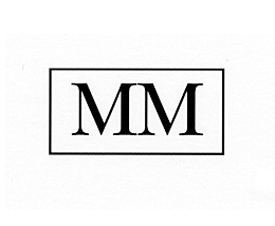 CAA seeks nominations and self-nominations for individuals to serve on the Millard Meiss Publication Fund Jury. Specialists in architectural history, Islamic art, Greek and Roman art, eighteenth or nineteenth-century art, modern art, and contemporary art are encouraged to apply for a four-year term, July 1, 2016–June 30, 2020. Candidates must be actively publishing scholars with demonstrated seniority and achievement; institutional affiliation is not required.
CAA seeks nominations and self-nominations for individuals to serve on the Millard Meiss Publication Fund Jury. Specialists in architectural history, Islamic art, Greek and Roman art, eighteenth or nineteenth-century art, modern art, and contemporary art are encouraged to apply for a four-year term, July 1, 2016–June 30, 2020. Candidates must be actively publishing scholars with demonstrated seniority and achievement; institutional affiliation is not required.
The Meiss jury awards subsidies to support the publication of book-length scholarly manuscripts in the history of art and related subjects. Members review manuscripts and grant applications twice a year and meet in New York in the spring and fall to select the awardees. CAA reimburses jury members for travel and lodging expenses in accordance with its travel policy. Members volunteer their services to CAA without compensation.
Candidates must be current CAA members and should not currently serve on another CAA editorial board or committee. Jury members may not themselves apply for a grant in this program during their term of service. Nominators should ascertain their nominee’s willingness to serve before submitting a name; self-nominations are also welcome. Please send a letter describing your interest in and qualifications for appointment, a CV, and contact information to: Millard Meiss Publication Fund Jury, College Art Association, 50 Broadway, 21st Floor, New York, NY 10004; or send all materials as email attachments to Deidre Thompson, CAA publications assistant, dthompson@collgeart.org. Deadline: April 21, 2016.
2016 Annual Conference Highlights
posted by Nia Page — February 26, 2016
 CAA hosted its 104th Annual Conference from February 3 to 6, 2016, at the Washington Marriott Wardman Park in Washington, DC. This year’s program included four days of presentations and panel discussions on art history and visual culture, Career Services for professionals at all stages of their careers, a Book and Trade Fair, and a host of special events throughout the region.
CAA hosted its 104th Annual Conference from February 3 to 6, 2016, at the Washington Marriott Wardman Park in Washington, DC. This year’s program included four days of presentations and panel discussions on art history and visual culture, Career Services for professionals at all stages of their careers, a Book and Trade Fair, and a host of special events throughout the region.
Attendance
Close to 4,000 people from throughout the United States and abroad—including artists, art historians, students, educators, curators, critics, collectors, and museum staff—attended the conference. Visual-arts professionals from over 49 countries were represented.
Sessions
Conference sessions featured presentations by artists, scholars, designers, graduate students, and curators who addressed a range of topics in art history and the visual arts. In total, the conference offered over 200 sessions, developed by CAA members, affiliated societies, and committees. Over 750 individuals presented their work.
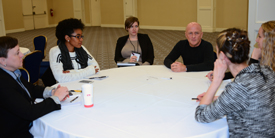 Career Services and Professional Development
Career Services and Professional Development
Career Services included four days of job interviews with colleges, universities, and other art institutions while Professional Development offerings included career mentoring and portfolio-review sessions, professional-development workshops, professional development roundtables and a variety of Student and Emerging Professional Committee programming such as Brown Bag discussions and Mock Interviews. During the professional development programming, approximately 30 professionals served as mentors to 120 young professionals, 5 established professionals led free professional roundtable discussions, and 13 Visual Arts specialists conducted development workshops throughout the conference. During the week of the Annual Conference, there were over 189 active jobs posted on the Online Career Center and more than 24 employers participating onsite.
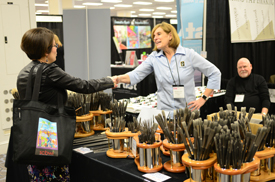 Book and Trade Fair
Book and Trade Fair
This year’s Book and Trade Fair presented 98 exhibitors—including participants from the United States, France, Germany, Belgium, Italy, Singapore, Canda, Mexico, United Kingdom and Ukraine—that displayed new publications, materials for artists, digital resources, and other innovative products of interest to artists, scholars, and arts enthusiasts. The Book and Trade Fair also featured book signings, lectures, and demonstrations, as well as three exhibitor-sponsored program sessions on art materials and publishing. The conference had generous sponsorship support from the exhibitors Artforum/Bookforum, Art in America, Blick Art Materials, Bloomsbury, Frieze, Laurence King Publishers, Pearson, Prestel, Richmond-The American International University in London, Routledge and Yale University Press.
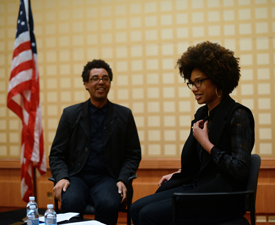 ARTspace
ARTspace
ARTspace, a “conference within the conference” tailored to the needs and interests of practicing artists, presented programming that was free and open to the public, including this year’s Annual Distinguished Artists’ Interviews with Joyce Scott who spoke with George Ciscle, Maryland Institute College of Art and Rick Lowe, who conversed with LaToya Ruby Frazier, Independent Artist and The School of the Art Institute, Chicago. The latter was presented as a partnership with the MacArthur Foundation to celebrate 35 years of its Fellowship program. Both Lowe and Frazier received MacArthur Fellowships in 2014 and 2015, respectively.
Watch the Annual Distinguished Artists’ Interviews
Over 150 people attended this lively event.
ARTspace also featured four days of panel discussions devoted to visual-arts practice, opportunities for professional development, and screenings of film and video.
ARTexchange, an open-portfolio event in which CAA artist members displayed drawings, prints, photographs, small paintings, and works on laptop computers, took place on Friday, February 5. Nearly 35 artists participated in ARTexchange this year.
The Media Lounge, a space for innovative new-media programming in conjunction with ARTspace. This year, the Media Lounge brought together academics, new media artists, artist collectives, alternative communities, guest speakers, filmmakers, and performers to lead workshops, present work, and generate productive discussions and crowd sourcing under the conceptual framework VISIBLE/INVISIBLE, Art & Politics.
The theme, VISIBLE/INVISIBLE, Art & Politics explored the legacy of identity and representation politics, considered in the context of our present culture where individuals, organizations and ideas can be easily captured, tracked, exposed, appropriated from the circulation of digital material which simultaneously feeds capitalist media assembly lines and alternative economies. The aim of the Media Lounge programming was to foster a dialog centered on emerging artistic sensibilities that mix art and a politics of representation amid a transforming sociopolitical landscape. The setting of CAA 2016, Washington DC and an election year, offered a unique opportunity to engage in these discussions.
ARTspace was made possible in part by a generous grant from the National Endowment for the Arts.
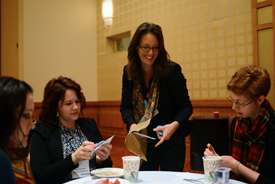 Student and Emerging Professionals Lounge
Student and Emerging Professionals Lounge
The Student and Emerging Professionals Lounge served as a hub for networking, information sharing, collaboration, professional development, and much more. The Student and Emerging Professionals Committee hosted an incredibly informative session on “Mentoring in the 21st Century” to a packed audience; a breakfast meet-and-greet with 200 attendees; five Brown Bag Sessions with attendance ranging from 45 to 160; a successful social night; and three days of Mock Interviews at full capacity.
Distinguished Scholar Session
Richard Powell, John Spencer Bassett Professor of Art and Art History and Dean of Humanities, Duke University was CAA’s 2016 Distinguished Scholar.
A panel including Kobena Mercer, Professor, History of Art and African American Studies at Yale University; Gwen Everett, Associate Dean of the Division of Fine Arts at Howard University; Kellie Jones, Associate Professor of Art History at Columbia University; and Suzanne Preston Blier, Allen Whitehill Clowes Professor of Fine Arts and of African and African American Studies at Harvard University joined in exploring and celebrating Powell’s many contributions.
Watch the Distinguished Scholar Session honoring Richard Powell.
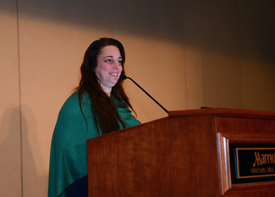 Convocation and Awards
Convocation and Awards
More than 1,000 people attended CAA’s Convocation and presentation of the annual Awards for Distinction, which honor the outstanding achievements and accomplishments of individual artists, art historians, authors, conservators, curators, and critics whose efforts transcend their individual disciplines and contribute to the profession as a whole and to the world at large. Tania Bruguera, the Cuban performance artist, delivered the keynote address.
Watch the CAA Convocation and Keynote Talk by Tania Bruguera.
The title of Bruguera’s talk was “Aest-ethics: Art with Consequences.” Bruguera’s work on issues of free speech and immigration and her fearlessness to speak out against forces of oppression—many of which she has experienced firsthand in Cuban prisons—is important and undeniably relevant to not just the art and academic worlds, but also the world at large.
The recipients of the 2016 Awards for Distinction were:
Charles Rufus Morey Book Award
Krista Thompson
Shine: The Visual Economy of Light in African Diasporic Aesthetic Practice
Duke University Press
Alfred H. Barr Jr. Award
Stephanie Barron and Sabine Eckmann
New Objectivity: Modern German Art in the Weimar Republic 1919–1933
Los Angeles County Museum of Art and DelMonico Books
Alfred H. Barr Jr. Award for Smaller Museums, Libraries, Collections, and Exhibitions
Myroslava M. Mudrak and Tetiana Rudenko
Staging the Ukrainian Avant-Garde of the 1910s and 1920s
Ukrainian Museum
Arthur Kingsley Porter Prize
Matthew C. Hunter
“Joshua Reynolds’s ‘Nice Chymistry’: Action and Accident in the 1770s”
The Art Bulletin, March 2015
Frank Jewett Mather Award for Art Criticism
Chika Okeke-Agulu
Postcolonial Modernism: Art and Decolonization in Twentieth-Century Nigeria
Duke University Press
Art Journal Award
Abigail Satinsky
“Movement Building for Beginners”
Art Journal, Fall 2015
Distinguished Feminist Award
Carrie Mae Weems
Distinguished Teaching of Art Award
Sabina Ott
Distinguished Teaching of Art History Award
Patricia Berger
Artist Award for Distinguished Body of Work
Arlene Shechet
Distinguished Artist Award for Lifetime Achievement
Carmen Herrera
CAA/American Institute for Conservation Award for Distinction in Scholarship and Conservation
Debra Hess Norris
Distinguished Lifetime Achievement Award for Writing on Art
Rosalind E. Krauss
Morey and Barr Award Finalists
CAA recognizes the 2016 finalists for the Charles Rufus Morey Book Award and the Alfred H. Barr Jr. Awards for their distinctive achievements:
Charles Rufus Morey Book Award Finalists
- Paul Binski, Gothic Wonder: Art, Artifice, and the Decorated Style, 1290–1350, Yale University Press, for the Paul Mellon Centre for Studies in British Art
- Elina Gertsman, Worlds Within: Opening the Medieval Shrine Madonna, Pennsylvania State University Press
- Adam Herring, Art and Vision in the Inca Empire: Andeans and Europeans at Cajamarca, Cambridge University Press
Alfred H. Barr Jr. Award Finalist
- Jens M. Daehner and Kenneth Lapatin, eds., Power and Pathos: Bronze Sculpture of the Hellenistic World, J. Paul Getty Museum
Alfred H. Barr Jr. Award for Smaller Museums, Libraries, Collections, and Exhibitions Finalist
- Timothy Verdon and Daniel M. Zolli, eds., Sculpture in the Age of Donatello: Renaissance Masterpieces from Florence Cathedral, Museum of Biblical Art, in association with D. Giles
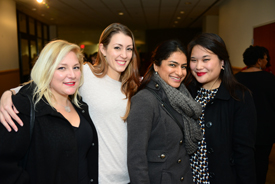 Special Events
Special Events
Following Convocation, the Katzen Arts Center at American University was host to CAA’s Opening Reception on Wednesday evening, February 3. Over 250 attendees gathered to celebrate the conference while enjoying a stroll through the museum’s permanent collections.
CAA Travel Grant in Memory of Archibald Cason Edwards, Senior, and Sarah Stanley Gordon Edwards
Established by Mary D. Edwards with the help of others, the CAA Travel Grant in Memory of Archibald Cason Edwards, Senior, and Sarah Stanley Gordon Edwards will support women who are emerging scholars at either an advanced stage of pursuing a doctoral degree (ABD) or who have received their PhD within the two years prior to the submission of the application. Diana Seave Greenwald of the University of Oxford delivered her paper “Within the grade of certain obvious criteria of merit:” Sample Bias in Art History and Earl Shinn’s The Art Treasures of America in the “Very Generally Ignorant, Flippant: Art Criticism and Mass Media in the Nineteenth Century” session and Imogen Wiltshire of the University of Birmingham presented her paper Process and Function at the New Bauhaus in Chicago: Concepts of Modernism and the Development of Therapeutic Art Practices as part of the “Modernism and Medicine” 2-part session.
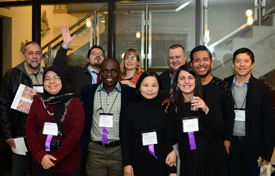 CAA-Getty International Travel Grant Program
CAA-Getty International Travel Grant Program
In an effort to promote greater interaction and exchange between American and international art historians, CAA brought 15 scholars from around the world to participate in the Annual Conference. This is the fifth year of the program, which has been generously funded by grants from the Getty Foundation since its inception.
The CAA-Getty International Program participants’ activities began with a one-day preconference colloquium on international issues in art history, during which they met with North American–based CAA members to discuss common interests and challenges. The participants were assisted throughout the conference by CAA member hosts, who recommended relevant panel sessions and introduced them to colleagues who share their interests.
Representatives from several CAA affiliated societies served as hosts, including the Arts Council of the African Studies Association, the Association for Latin American Art, the Society of Contemporary Art Historians, and the Society of Historians of East European, Eurasia, and Russian Art and Architecture. More information about the group’s activities will appear in upcoming articles in CAA News and on the International Desk of the CAA website.
To date, this program has brought 90 scholars from 41 different countries to participate in CAA’s Annual Conference and expanded international networking and the exchange of ideas both during and after the conference.
The 2016 recipients were: Sarena Abdullah, Senior Lecturer, School of the Arts, Universiti Sains Malaysia, Penang; Abiodun Akande, Principal Lecturer, Department of Fine and Applied Arts, Emmanuel Alayande College of Education, Oyo State, Nigeria; María Isabel Baldasarre, Associate Professor, Universidad Nacional de San Martin, Buenos Aires, Argentina; Danielle Becker, Lecturer in Art History and Visual Studies, University of Cape Town and Stellenbosch University, South Africa; Heloisa Espada, Postdoctoral Researcher, Museum of Contemporary Art of the University of Saõ Paulo, Brazil; Ildikó Fehér, Associate Professor, Art History Department, University of Fine Arts of Hungary, Budapest, Hungary; Peyvand Firouzeh, Post-doctoral Fellow, Museum fur Islamische Kunst, Berlin, Germany; Lev Maciel, Associate Professor, National Research University, Higher School of Economics, Moscow, Russia; Bui Thi Thanh Mai, Lecturer of Art History, Head of Department of Academic Research Management and International relations, Vietnam University of Fine Arts, Ha Noi, Vietnam; Emmanuel Moutafov, Associate Professor, Director, Institute of Art Studies, Bulgarian Academy of Sciences, Sofia, Bulgaria; Ceren Ozpinar, Lecturer, Isik University and Kadir Has University, Istanbul, Turkey; Horacio Ramos, Associate Professor, Pontificia Universidad Católica del Perú; Olaya Sanfuentes, Professor, Pontificia Universidad Católica de Chile, Paulo Silveira, Professor, Universidade Federal do Rio Grande do Sul, Porto Alegre, Brazil; Sandra Uskokovic, Assistant Professor, University of Dubrovnik, Arts & Restoration Department, Croatia.
 CAA 2015 Professional-Development Fellowships
CAA 2015 Professional-Development Fellowships
CAA awarded four 2015 Professional-Development Fellowships—two in the visual arts and two in art history—to graduate students in MFA and PhD programs across the United States. In addition, CAA has named two honorable mentions in art history and four in the visual arts. The fellows and honorable mentions also receive a complimentary one-year CAA membership and free registration for the 2016 Annual Conference where they were honored at Convocation and at a private reception.
Recipients of the fellowships in the visual arts were:
- Delano Dunn, School of Visual Arts, $10,000
- Derrick Woods-Morrow, School of the Art Institute of Chicago, $4,000 (gift of the Milton and Sally Avery Arts Foundation)
Recipients of the fellowship in art history were:
- Marin Sarvé-Tarr, University of Chicago, $10,000
- Emilie Boone, Northwestern University, $2,500 (gift of the Elizabeth A. Sackler Museum Educational Trust)
The honorable mentions for art history were awarded to: Adrian Anagnost, University of Chicago; and Monica Bravo, Brown University. For the visual arts, honorable mentions are bestowed upon: Zhiwan Cheung, Carnegie Mellon University; Sarah Hewitt, Purchase College, State University of New York; Victoria Maidhof, San Francisco Art Institute; and Kaiya Rainbolt, San Diego State University.
Board of Directors Update
Results of the Board of Directors election were announced on February 3, 2016, during the Annual Members’ Business Meeting. The new directors are: appear below.
- Carma Gorman Associate Professor & Assistant Chair, Department of Art and Art History, University of Texas at Austin
- Elizabeth Schlatter Deputy Director and Curator of Exhibitions, University of Richmond Museums, Richmond
- Andrew Schulz Associate Dean for Research & Associate Professor, College of Arts and Architecture, Pennsylvania State University
- Anuradha Vikram Lecturer, Graduate Public Practice, Otis College of Art and Design, Los Angeles
They will take office at the next board meeting in May 2016.
New board officers were elected:
- Doralynn Pines, Vice President for External Affairs
- Jim Hopfensberger, Vice President for Committees
Affiliated Societies
CAA would like to welcome two new affiliated societies:
Thank You
Members of CAA’s Board of Directors and staff would like to extend their gratitude to all conference funders and sponsors, attendees, volunteers, and participants; the organization’s committees and award juries; the Washington Marriott Wardman Park staff; the museums and galleries that opened their doors to conference attendees free of charge; and everyone else involved in helping to make the 104th Annual Conference such a tremendous success!
A warm thanks to the following for their generous support of CAA:
- Andrew W. Mellon Foundation
- Artforum/Bookforum
- Art in America
- Blick Art Materials
- Bloomsbury
- Frieze
- Getty Foundation
- Katzen Arts Center
- Laurence King Publishing
- National Endowment for the Arts
- Pearson
- Prestel
- Richmond, The American International University in London
- Routledge
- Samuel H. Kress Foundation
- Terra Foundation for American Art
- Wyeth Foundation for American Art
- Yale University Press
Save the Date
CAA’s 105th Annual Conference will be held in New York, February 15–18, 2017.
About CAA
The College Art Association is dedicated to providing professional services and resources for artists, art historians, and students in the visual arts. CAA serves as an advocate and a resource for individuals and institutions nationally and internationally by offering forums to discuss the latest developments in the visual arts and art history through its Annual Conference, publications, exhibitions, websites, and other events. CAA focuses on a wide range of issues, including education in the arts, freedom of expression, intellectual-property rights, cultural heritage and preservation, workforce topics in universities and museums, and access to networked information technologies. Representing its members’ professional needs since 1911, CAA is committed to the highest professional and ethical standards of scholarship, creativity, criticism, and teaching.
Image Captions
Conference attendees gather for a Professional Development Roundtable (photograph by Bradley Marks)
Conference attendees meet vendors in the Book and Trade Fair (photograph by Bradley Marks)
Rick Lowe and LaToya Ruby Frazier in conversation in ARTspace (photograph by Bradley Marks)
Mentoring activities in the SEP Lounge (photograph by Bradley Marks)
Tania Bruguera speaks at Convocation (photograph by Bradley Marks)
Friends gather at the Opening Reception at the Katzen Art Center (photograph by Bradley Marks)
The 2016 participants in the CAA-Getty International Program (photograph by Bradley Marks)
Fellowship recipients and honorable mentions in art history (photograph by Bradley Marks)
News from the Art and Academic Worlds
posted by Christopher Howard — February 24, 2016
Each week CAA News publishes summaries of eight articles, published around the web, that CAA members may find interesting and useful in their professional and creative lives.
How Can Nonprofits Improve Their Governance?
Governance is coming up more frequently as a subject of conversation and concern among executives and managers in nonprofit organizations. The topic’s rising prominence coincides with more acute financial stresses and vexing strategic conundrums, both of which traditional governance bodies are finding difficult to handle. Executives are duly concerned. (Read more from the Scholarly Kitchen.)
Help Desk: Institutional Bias
I freelance in a museum in a major metropolitan area with a diverse population, but the racial demographics of the institution’s staffing seem glaringly segregated. The white-collar office employees are mostly white, while black and brown employees make up almost all of the security department. While I haven’t felt any discrimination, the racial dynamics seem obvious and weird to me. What should I do? (Read more from Daily Serving.)
Testing the Possibilities of Online Education with Museum MOOCs
Massive open online courses (MOOCs) have been hailed as a possible solution to providing low-cost, high-quality education and derided as a destructive reallocation of resources from public education to private corporations. Much existing debate is centered on replacing a physical experience of education with a virtual one; the dispute is also entangled with rising educational costs in the United States. (Read more from Hyperallergic.)
No Rush to “Go Digital”
Quality, cost, and reputation are the top three factors that influence how faculty members pick which textbooks and course materials they assign, according to results from a survey of faculty at two- and four-year institutions. Virtually every respondent for “Going Digital” said their own assessment of the quality of a textbook is an important or a very important factor influencing their course material selection process, followed by the cost and a near tie between comments from colleagues and students or teaching assistants. Less than one-third of respondents said the availability of digital supplements played an important role. (Read more from Inside Higher Ed.)
Librarians Find Themselves Caught between Journal Pirates and Publishers
The rise, fall, and resurfacing of a popular piracy website for scholarly-journal articles, Sci-Hub, has highlighted tensions between academic librarians and scholarly publishers. Academics are increasingly turning to websites like Sci-Hub to view subscriber-only articles that they cannot obtain at their college or that they need more quickly than interlibrary loan can provide. (Read more from Chronicle of Higher Education.)
How Digital Storage Is Changing the Way We Preserve History
A few years ago, I started using a digital diary platform called Oh Life. I’d relied on a notebook to jot down daily reflections for years, but this was infinitely more elegant. It was more private than a notebook and less clunky, and the platform even let users upload entries by sending an email. But when I logged on recently, searching for something I’d written on Oh Life years ago, all of my entries had vanished. In fact, the whole site had been shut down, and years of my personal history were gone. (Read more from Vice.)
A Strategy Guide for Second-Round Interviews
Interviewing for an academic job is a grueling, anxiety-ridden, and all-around intense experience for candidates, and the competition at the campus-interview stage is stiffer than ever. The key to staying in the game is to focus on what you can control and carry on when things don’t go your way. (Read more from Vitae.)
What Is SoTL?
Art History Teaching Resources’s 2015 survey found that many art historians are unfamiliar with the Scholarship of Teaching and Learning (SoTL). This relative new area of research originated in the 1990s, growing out of the Carnegie Foundation for the Advancement of Teaching and the recognition, elegantly expressed in Ernest Boyert’s Scholarship Reconsidered: Priorities of the Professoriate, that teaching is an essential part of scholarly activity. (Read more from Art History Teaching Resources.)
Case Studies and Examples for Evaluating Digital Scholarship
posted by michelle — February 23, 2016
Strong case studies of digital humanities scholarship exist, and compelling resources continue to proliferate. Scholarly societies, including the American Historical Association (AHA), Modern Language Association (MLA), and more recently the College Art Association (CAA), and Society of Architectural Historians (SAH) have developed guidelines for use by institutions and individuals. Funded by a grant from the Andrew W. Mellon Foundation, CAA and SAH formed a joint task force that explored existing guidelines and literature, surveyed faculty and administrators, and developed Guidelines for the Evaluation of Digital Scholarship in Art and Architectural History. Adopted by the boards of both societies, the guidelines are available for download on the SAH and CAA websites and we encourage their adoption and use. The task force reviewed many resources in the course of eighteen months. Some of these are described below to provide a context for current digital evaluation in addition to the recently published CAA/SAH guidelines.
Sources such as the Journal of Interactive Pedagogy and Pedagogy and Manifold Scholarship, and sites such as Mapping Gothic France, HyperCities, and ArtHistoryTeachingResources.org are places where digital scholarship is being practiced, peer reviewed, and successfully included in promotion and tenure portfolios. Benchmark portals such as the NINES (Networked Infrastructure for Nineteenth-Century Electronic Scholarship) NEH Summer Institutes (Storify of the proceedings can be found here) offer useful white papers: “Digital Humanities Scholarship: Recommendations for Chairs in Language and Literature Departments“; “Guidelines for Promotion and Tenure Committees in Judging Digital Work”; and “Statement on Authorship.” Kristine M. Bartanen’s excellent “Digital Scholarship and the Tenure and Promotion Process“ contains valuable guidance. Published to Academic Commons in July 2014, Bartenan provides a comprehensive literature review and resource portal for the evaluation of digital scholarship. The review contains both model guidelines for promotion and tenure and appendices for a range of resources, literature, and organizations pertinent to understanding and developing evaluation methods.
In the fall of 2012 the Journal of Digital Humanities published their fourth issue, which centered on the “importance of assessment and the scholarly vetting process around digital scholarship.”[1] (The full journal issue can be accessed here.) The issue addresses the need for guidelines and dialogue for assessing digital scholarship in the humanities, offers case studies and examples, and reflects on the successes, issues, and failures of the methods employed. Though much of the content is not art or architectural history-specific, it is still relevant to CAA’s and SAH’s memberships. A broad overview of the contents of this journal issue is provided below so that readers can zero in on the material most germane to their own needs. Readers are encouraged to make use of the excellent bibliographies attached to each of the issue’s essays.
The issue is divided into four major sections: “The Problem Stated,” “Approaches,” “Institutional Guidelines,” and “Resources.” In the introductory section of “Living in a Digital World: Rethinking Peer Review, Collaboration, and Open Access,” Sheila Cavanagh highlights the importance of retraining processes and expectations of evaluation around digital scholarship, including “encouraging faculty who hire, tenure, and mentor junior scholars to acknowledge the complicated factors in the world of digital scholarship . . . for example, faculty often have difficulty identifying appropriate experts to participate in more traditional peer review processes.”[2] In “Evaluating Collaborative Digital Scholarship (or, Where Credit is Due),” Bethany Nowviskie highlights the inability of many humanities evaluative committees to adequately understand and appropriately review and reward the type of collaborative work that digital scholarship is often predicated upon. She contends that “the T&P [tenure and promotion] process is a poor fit to good assessment (or even, really, to acknowledgement) of collaborative work, because it has evolved to focus too much on a particular fiction. That fiction is one of ‘final outputs’ in digital scholarship.”[3]
The “Student Collaborators’ Bill of Rights“ from UCLA’s Digital Humanities program provides important guidance about how to understand, review, and reward collaborative digital humanities scholarship, especially in light of hierarchies of power experienced by student and “alt-ac” collaborators.[4] Nowviskie hails certain aspects of the AHA Guidelines for Evaluation of Digital Scholarship, particularly their underscoring of collaborative digital work as a type of perpetual peer review. At a National Endowment for the Humanities “Off the Tracks” workshop in 2011, Nowviskie, Matt Kirschenbaum, Doug Reside, and Tom Scheinfeldt collaborated on a provocative “Bill of Rights” for collaborators that might serve as a guidepost for promotion and tenure committees to consider. In Nowviskie’s words, “We drew on our experience administering MITH [Maryland Institute for Technology in the Humanities], the Scholars’ Lab, and the Roy Rosenzweig Center for History and New Media—three centers that are sites for a great deal of collaboration among people who may have similar backgrounds as scholars and technologists, but whose formal institutional status may vary a great deal. We drafted something we called a ‘Collaborators’ Bill of Rights,’ which was later endorsed by the full workshop assembly and posted for public comment. Basically, it’s an appeal for fair, honest, legible, portable (this is important!), and prominently displayed crediting mechanisms. It also offers a dense expression of underlying requirements for healthy collaboration and adequate assessment from the point of view of practicing digital humanists, with special attention to the vulnerabilities of early-career scholars and staff or non-tenure-track faculty.” Their recommendations are as follows:
- Committees must consider not only the products of digital work but the processes by which the work was (and perhaps continues to be) co-created;
- Scholars (even while they ask to have their critical agency as individuals taken seriously in tenure and promotion cases) are obligated to make the most generous and inclusive statements possible about the contributions of others;
- Credit should be expressed richly and descriptively, but also in increasingly standardized forms, legible within a variety of disciplines and communities of practice;
- We must negotiate expressions of shared credit at the outset of projects and continually, as projects evolve;
- We must promote fair institutional policies and practices in support of shared assertion of credit, such as those which make collective and individual ownership over intellectual property meaningful and actionable;
- And, finally, we must accept that collaborators themselves, regardless of rank or status, have the ultimate authority and responsibility for expressing their contributions and the nature of their roles.
Other relevant literature includes Todd Presner’s essay “How to Evaluate Digital Scholarship,” directed at the audiences within the art and architectural history-specific community: “The document is aimed, foremost, at Academic Review Committees, Chairs, Deans, and Provosts who want to know how to assess and evaluate digital scholarship in the hiring, tenure, and promotion process. Secondarily, the document is intended to inform the development of university-wide policies for supporting and evaluating such scholarship.”[5] Presner offers a succinct and clear checklist for promotion and tenure boards, engaging them in dialogue around initial review, crediting, intellectual rigor, impact, peer review, and experimentation, among other topics.
Geoffrey Rockwell’s “Short Guide to Evaluation of Digital Work” deepens and extends Presner’s checklist in compelling and practicable ways, and Laura Mandell’s essay “Promotion and Tenure for Digital Scholarship” offers a useful and clear coda full of concrete examples such as the HyperCities project and Voyant, a software text analysis tool. It is not overstating the importance of these three essays alone to suggest that every promotion and tenure board member might be asked to read them to educate themselves on the shifting boundaries of their discipline, and the ways in which their analysis of promotion and tenure portfolios must change and adapt. In addition, in the third section of the journal issue, the MLA’s Guidelines for Evaluating Work in Digital Humanities and Digital Media is similarly designed to “help departments and faculty members implement effective evaluation procedures for hiring, reappointment, tenure, and promotion. They apply to scholars working with digital media as their subject matter and to those who use digital methods or whose work takes digital form.”[6]
James Smithies’s essay “Evaluating Scholarly Digital Outputs: The Six Layers Approach” offers a different style of checklist, a bird’s-eye view of the different types of digital scholarship output, but one that is most useful if the reader—part of a promotion and tenure board or otherwise—is already informed about and open to considering digital scholarship on par with analog modes. Katherine D. Harris’s “Explaining Digital Humanities in Promotion Documents” is a comprehensive and fruitful overview of her foray into learning “how best to sell Digital Humanities, scholarly editing, and Digital Pedagogy to my colleagues.”[7] Harris, associate professor of English literature at San Jose State University, shares her statement for promotion and her approach to the practical question of formatting and outlining her digital scholarship as part of her promotion and tenure binder. With few models to consult, she crowdsourced her questions via Twitter and other channels in order to produce her promotion and tenure document, finally settling on a narrative-based approach that outlines her own collaborative and individual contributions to the field, and includes examples of her concrete research and pedagogy projects in progress and completed, publications, conferences, and supporting quotations from the Digital Humanities Community Wiki and Digital Humanities Now.
While every essay in the fall 2012 Journal of Digital Humanities issue is well worth consultation, the final resource to flag is the MLA’s “Evaluation Wiki of the Committee on Information Technology.” This report takes the form of a checklist of documents that digital scholars should amass as part of preparation for promotion and tenure, and it might be used in tandem with Harris’s model statement.
Both CAA and SAH leadership teams encourage the wide dissemination and adoption of the newly published guidelines, as well as a CAA 2017 panel or forum models that facilitate questions, feedback, and discussion around the issues raised.
Michelle Millar Fisher is a doctoral candidate in Architectural History at the CUNY Graduate Center and a Curatorial Assistant in the Department of Architecture and Design at The Museum of Modern Art.
[1] Daniel J. Cohen and Joan Fragaszy Troyano, “Closing the Evaluation Gap,” Journal of Digital Humanities vol. 1, no. 4 (Fall 2012): i. They continued: “As digital humanities continues to grow and as more scholars and disciplines become invested in its methods and results, institutions and scholars increasingly have been debating how to maintain academic rigor while accepting new genres and the openness that the web promotes.”
[2] Ibid, 9.
[3] Ibid, 17.
[4] Authored by Haley Di Pressi, Stephanie Gorman, Miriam Posner, Raphael Sasayama, and Tori Schmitt, with contributions from Roderic Crooks, Megan Driscoll, Amy Earhart, Spencer Keralis, Tiffany Naiman, and Todd Presner, this document endorses the Collaborators Bill of Rights, developed during the workshop “Off the Tracks—Laying New Lines for Digital Humanities Scholars” held at the Maryland Institute for Technology in the Humanities (MITH), January 20–21, 2011, and described below. The UCLA document adds principles to safeguard students when working on projects with scholars who are senior to them.
[5] Ibid, 36.
[6] Ibid, 91–94.
[7] Ibid, 71.
CAA and SAH Release Guidelines for the Evaluation of Digital Scholarship in Art and Architectural History
posted by Christopher Howard — February 23, 2016
The College Art Association (CAA), working jointly with the Society of Architectural Historians (SAH), has released its Guidelines for the Evaluation of Digital Scholarship in Art and Architectural History for Promotion and Tenure. The guidelines are the result of a Task Force convened by the two associations of ten members from the academic community with experience in digital research, publication, and/or scholarly communications and administration. Established by the Board of Directors in October 2014 and supported by funds from the Andrew W. Mellon Foundation, this joint task force of CAA and SAH was co-chaired by DeWitt Godfrey, president, CAA and professor of art and art history, Colgate University; and Kenneth Breisch, SAH president and assistant professor, School of Architecture, University of Southern California.
See the SAH announcement.
The project methodology was developed through a collaborative process involving the Task Force, consultant, researcher, and representatives from CAA and SAH. Research components included results from surveys of CAA and SAH members and department chairs, a similar questionnaire for graduate students, interviews with scholars and administrators, research on existing disciplinary and institutional evaluation guidelines, and a review of relevant literature. Alice Lynn McMichael, PhD candidate in Byzantine art history and digital fellow at the Graduate Center at the City University of New York, and Raym Crow, principal at Chain Bridge Group served as researcher and consultant.
In addition to a review of current guidelines and current literature on the topic, the researcher was charged with balancing broad survey data with more in-depth discussions of topics that resonate with evaluators of digital work. To this end, interviews were conducted with constituents from sixteen institutions across the United States that produce digital work regularly in art and/or architectural history. Institutions were either public and private and research-intensive or teaching-focused. Interviewees at those institutions had varying academic ranks and included department members, librarians, provosts, deans, chairs, and directors of humanities centers or similar.
Highlights from surveys from CAA and SAH members and interviews include the following:
- Most CAA respondents, across all professional ranks, have never used data gathering and imaging tools (83%), data analysis and visualization tools (80%), three-dimensional modeling (75%), digital storage and preservation tools (73%), and geospatial analysis tools (65%).
- Many characteristics of digital resources were generally valued as important, with the highest importance placed on permanent archiving, documentation of the resource, and ease of use; and relatively less importance on the availability of underlying data, financial sustainability, and permanent citation.
- Graduate students report the highest confidence in evaluating digital scholarship.
- Less than 4 percent of total respondents knew of existing evaluative criteria for digital scholarship in their departments.
- The largest barrier to digital scholarship is lack of access to training.
Read the full Guidelines here. An essay, “Case Studies and Examples for Evaluating Digital Scholarship” by Michelle Millar Fisher, a task force member, provides background information on evaluating digital resources and can be found on the College Art Association website.
Members of the Task Force included:
- Suzanne Preston Blier, Allen Whitehall Clowes Professor of Fine Arts and of African and African American Studies, Harvard University
- Kenneth Breisch, SAH President, Assistant Professor, School of Architecture, University of Southern California, and Cochair of Task Force
- Linda Downs (ex officio), Executive Director, College Art Association
- Gabrielle Esperdy, Associate Professor, School of Architecture, New Jersey Institute of Technology, and Editor of SAH Archipedia
- Michelle Miller Fisher, PhD Candidate, Art History, The Graduate Center, The City University of New York, and Curatorial Assistant, Department of Architecture and Design, Museum of Modern Art
- Pamela M. Fletcher, Professor of Art History, Chair of Art Department, and Codirector of Digital and Computational Studies Initiative, Bowdoin College
- DeWitt Godfrey, CAA President, Professor of Art and Art History, Colgate University, and Cochair of Task Force
- Anne Collins Goodyear, Codirector, Bowdoin College Museum of Art
- Paul Jaskot, Professor, History of Art and Architecture, DePaul University, and Andrew W. Mellon Professor, CASVA
- Bruce M. Mackh, Director, Arts and Cultural Management Program, Michigan State University
- Tara McPherson, Associate Professor, School of Cinematic Arts, University of Southern California
- Abby Smith Rumsey, Former Director, Scholarly Communication Institute, University of Virginia
- Pauline Saliga (ex officio), Executive Director, Society of Architectural Historians
- Ann Whiteside, Librarian and Assistant Dean of Information Services, Harvard University
About CAA
The College Art Association is dedicated to providing professional services and resources for artists, art historians, and students in the visual arts. CAA serves as an advocate and a resource for individuals and institutions nationally and internationally by offering forums to discuss the latest developments in the visual arts and art history through its Annual Conference, publications, exhibitions, website, and other programs, services, and events. CAA focuses on a wide range of issues, including education in the arts, freedom of expression, intellectual-property rights, cultural heritage, preservation, workforce topics in universities and museums, and access to networked information technologies. Representing its members’ professional needs since 1911, CAA is committed to the highest professional and ethical standards of scholarship, creativity, criticism, and teaching. Learn more at collegeart.org.
About SAH
Founded in 1940, the Society of Architectural Historians is a nonprofit membership organization that promotes the study, interpretation and conservation of architecture, design, landscapes and urbanism worldwide. SAH serves a network of local, national and international institutions and individuals who, by vocation or avocation, focus on the built environment and its role in shaping contemporary life. SAH promotes meaningful public engagement with the history of the built environment through advocacy efforts, print and online publications, and local, national and international programs. Learn more at sah.org.
Art Journal Editorial Board Seeks New Members
posted by CAA — February 23, 2016
 CAA invites nominations and self-nominations for three individuals to serve on the Art Journal Editorial Board for a four-year term: July 1, 2016–June 30, 2020. Candidates may be artists, art historians, art critics, art educators, curators, or other art professionals; institutional affiliation is not required. Art Journal, published quarterly by CAA, is devoted to twentieth- and twenty-first-century art and visual culture.
CAA invites nominations and self-nominations for three individuals to serve on the Art Journal Editorial Board for a four-year term: July 1, 2016–June 30, 2020. Candidates may be artists, art historians, art critics, art educators, curators, or other art professionals; institutional affiliation is not required. Art Journal, published quarterly by CAA, is devoted to twentieth- and twenty-first-century art and visual culture.
The editorial board advises the Art Journal editor-in-chief and assists her or him in seeking authors, articles, artists’ projects, and other content for the journal; performs peer review and recommends peer reviewers; guides its editorial program and may propose new initiatives for it; and may support fundraising efforts on the journal’s behalf. Members also assist the editor-in-chief to keep abreast of trends and issues in the field by attending and reporting on sessions at the CAA Annual Conference and other academic conferences, symposia, and events.
The Art Journal Editorial Board meets three times a year, with meetings in the spring and fall plus one at the CAA Annual Conference in February. The spring and fall meetings are currently held by teleconference, but at a later date CAA may reimburse members for travel and lodging expenses for the two New York meetings in accordance with its travel policy. Members pay travel and lodging expenses to attend the conference in February. Members of all editorial boards volunteer their services to CAA without compensation.
Candidates must be current CAA members and should not be serving on the editorial board of a competitive journal or on another CAA editorial board or committee. Members may not publish their own work in the journal during the term of service. Nominators should ascertain their nominee’s willingness to serve before submitting a name; self-nominations are also welcome. Please send a letter describing your interest in and qualifications for appointment, a CV, and your contact information to: Chair, Art Journal Editorial Board, College Art Association, 50 Broadway, 21st Floor, New York, NY 10004; or email the documents to Joe Hannan, CAA editorial director. Deadline: April 15, 2016.
CAA Announces Formation of Committee on Design
posted by CAA — February 23, 2016
Dear College Art Association Members:
In 2015, CAA established a Task Force on Design charged with suggesting positions the organization might adopt toward design, design studies, designers, design educators, historians, and theorists. The CAA Board of Directors is delighted to announce the approval of a new Committee on Design, approved during the recently concluded 2016 CAA Annual Conference.
The Committee will replace the Task Force and be among CAA’s ten standing Professional Interests, Practices, and Standards Committees. The Committee on Design will promote and advance issues in design practice, design history/theory/criticism, and design education through advocacy, engagement, and a commitment to the diversity of practices and practitioners. The committee will further support discussion and action in these areas to stimulate intellectual curiosity and advance skills that enrich the individual and society.
CAA invites members to apply for service on this inaugural Committee on Design. To apply, kindly forward a statement of interest (250 words or less) and a 3–4 page condensed résumé noting in the subject line Committee on Design to vjalet@collegeart.org. Initial application review begins on March 30, 2016, with appointments to two-year terms anticipated by May 1, 2016.
Until May 1, the Task Force on Design will continue work on revising CAA’s Standards and Guidelines for Retention and Tenure of Art and Design Faculty and seeks input from CAA members. We invite you to review and comment upon the current draft. Please send any comments and/or questions to designfeedback@collegeart.org.
Responses at your earliest convenience, and especially prior to March 15, 2016, are greatly appreciated as the Task Force wishes to complete this project for a May 2016 approval by the CAA Board of Directors.
Thank you in advance for input toward advancing design interests within CAA.
Sincerely,
DeWitt Godfrey,
President
Jim Hopfensperger, Chair,
CAA Task Force on Design
Solo Exhibitions by Artist Members
posted by CAA — February 22, 2016
See when and where CAA members are exhibiting their art, and view images of their work.
Solo Exhibitions by Artist Members is published every two months: in February, April, June, August, October, and December. To learn more about submitting a listing, please follow the instructions on the main Member News page.
February 2016
Abroad
Mark Staff Brandl. Jedlitschka Gallery, Zurich, Switzerland, November 20, 2015–January 15, 2016. Painting Acted Artists. Painting.
Mid-Atlantic
FICTILIS (Andrea Steves and Timothy Furstnau). Atrium Gallery, Corcoran School of the Arts and Design, George Washington University, Washington, DC, February 5–March 13, 2015. Wildcat Hauling: Making Waste Public. Social practice and installation.
Reni Gower. Neil Britton Gallery, Virginia Wesleyan College, Norfolk, Virginia, November 13, 2015–January 13, 2016. Strange Loops. Painting, collage, and assemblage.
Linda Stein. Noyes Museum of Art, Stockton University, Oceanville, New Jersey, September 21, 2015–January 3, 2016. The Fluidity of Gender: Sculpture by Linda Stein. Sculpture.
Art Bulletin Editorial Board Seeks a New Member
posted by CAA — February 22, 2016
 CAA invites nominations and self-nominations for one individual to serve on the Art Bulletin Editorial Board for a four-year term, July 1, 2016–June 30, 2020. The ideal candidate has published substantially in the field and may be an academic, museum-based, or independent scholar; institutional affiliation is not required. The Art Bulletin features leading scholarship in the English language in all aspects of art history as practiced in the academy, museums, and other institutions.
CAA invites nominations and self-nominations for one individual to serve on the Art Bulletin Editorial Board for a four-year term, July 1, 2016–June 30, 2020. The ideal candidate has published substantially in the field and may be an academic, museum-based, or independent scholar; institutional affiliation is not required. The Art Bulletin features leading scholarship in the English language in all aspects of art history as practiced in the academy, museums, and other institutions.
The editorial board advises the Art Bulletin editor-in-chief and assists her or him in seeking authors, articles, and other content for the journal; performs peer review and recommends peer reviewers; may propose new initiatives for the journal; and may support fundraising efforts on the journal’s behalf. Members also assist the editor-in-chief to keep abreast of trends and issues in the field by attending and reporting on sessions at the CAA Annual Conference and other academic conferences, symposia, and events.
The Art Bulletin Editorial Board meets three times a year, with meetings in the spring and fall plus one at the CAA Annual Conference in February. The spring and fall meetings are currently held by teleconference, but at a later date CAA may reimburse members for travel and lodging expenses for the two New York meetings in accordance with its travel policy. Members pay travel and lodging expenses to attend the conference in February. Members of all editorial boards volunteer their services to CAA without compensation.
Candidates must be current CAA members and should not be serving on the editorial board of a competitive journal or on another CAA editorial board or committee. Members may not publish their own work in the journal during the term of service. Nominators should ascertain their nominee’s willingness to serve before submitting a name; self-nominations are also welcome. Please send a letter describing your interest in and qualifications for appointment, a CV, and your contact information to: Chair, Art Bulletin Editorial Board, College Art Association, 50 Broadway, 21st Floor, New York, NY 10004; or email the documents to Joe Hannan, CAA editorial director, at jhannan@collegeart.org. Deadline: April 15, 2016.




 Invitation card for Painting Acted Artists
Invitation card for Painting Acted Artists
 FICTILIS, Wildcat Hauling, January 2015 (artwork © FICTILIS)
FICTILIS, Wildcat Hauling, January 2015 (artwork © FICTILIS)

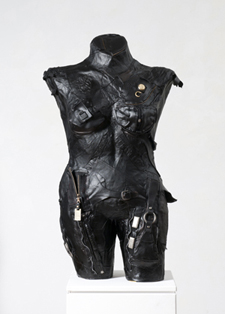 Linda Stein, Defender 696, 2010, leather, metal, and mixed media, 38 x 22 x 14 in. (artwork © Linda Stein)
Linda Stein, Defender 696, 2010, leather, metal, and mixed media, 38 x 22 x 14 in. (artwork © Linda Stein)